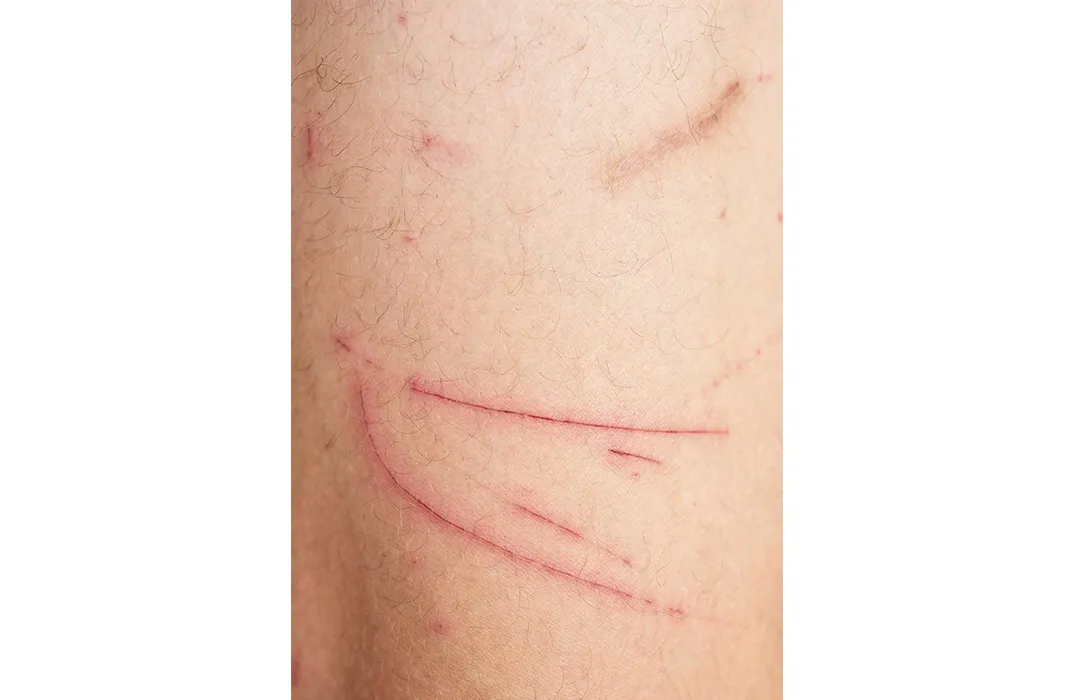Why Does Skin Repair Rapidly And Completely?
Skin serves many purposes. Information technology protects our internal workings, information technology tin can reflect our mood and our wellness, and it provides an exterior protective wrapping. When peel is damaged, the repair process is non just a biological curiosity, it can exist a matter of life and decease.
The skin is an organ system, weighing eight pounds on average, that regulates body temperature, senses pleasant and painful stimuli and temperature, secretes sweat and oils, and helps protect us from the harmful effects of ultraviolet radiation.
Skin is as unique as each one of us, so it's non surprising that even though there's a general healing procedure, non anybody heals the same way.
"Wound healing is extraordinarily complex, and has lots of external and internal factors," says Adam Friedman, an associate professor of dermatology at George Washington University School of Medicine and Health Sciences. "There's no 1-size-fits-all arroyo. You lot have to accept the wound and the person into business relationship when figuring out an algorithm of healing," says Friedman.
Typically, healing is initially dictated past the depth of the wound. Superficial wounds tend to reach only into the epidermis. That's the top-most layer of skin, which is very thin. The upper function of the epidermis contains keratin, a substance made from dead cells that helps protect the pare from harmful substances. The bottom office contains melanocytes, which are cells that produce the dark-colored pigments known as melanin.

A scrape of the epidermis won't draw blood and heals easily and quickly, says Friedman. Some very deep wounds—such as pressure sores or burns—don't bleed either. The deeper a cut or puncture wound or burn, the more has to happen for healing. Deeper wounds extend into the dermis—which contains blood vessels, nerves, pilus follicles, sweat and oil glands and the back up structures, including collagen and elastin—or even deeper, into the body'due south fat layer.
Wounds always heal from the inside out and from the edges in. In a good for you person it works this way: Inside seconds to minutes of an injury, blood vessels will constrict to reduce bleeding. Platelets—sticky blood cells—flood the expanse and aggregate into clumps. Clotting factors soon come on the scene, joining with the platelets to grade a clot. Meanwhile, white claret cells (macrophages) come through, scavenging for infectious invaders. Over the adjacent few days, macrophages also brand growth factors to help repair the wound.
The clots turn into scabs, and, underneath, fibroblast cells produce collagen, a poly peptide that connects tissues together. In a weeks-long process, the collagen creates new capillaries and the skin on the edges of the wound gets thicker and starts stretching under the scab. The pare might look crimson and start to itch—a normal part of healing, says Friedman. The nervus cells transport itch signals in response to the perceived movement of the new pare coming in, he says.
The scab normally falls off by itself—that is, unless it is picked off. That shouldn't be done, only the wound shouldn't exist immune to dry out out, either, says Friedman. Dry, crusty scabs are like brick walls preventing new cells from migrating to the wound and can too be a food source for bacteria, he says.
To prevent the area from drying out, he recommends a coat of petroleum jelly with a cast on top. Offset, a wound should be cleaned with lather and water. Alcohol and peroxide are okay initially, but unnecessary, and repeated employ actually is toxic to the new peel and retards healing. Use of antibacterial ointments is likewise totally unnecessary, unless the wound is already infected. Otherwise, they could cause bacterial resistance or allergic reactions.
It's particularly important to proceed a new wound protected from sunday exposure. The radiation tin can promote inflammation and interfere with the rebuilding process, says Friedman.
Nearly every deeper wound forms a scar, which is basically pare that isn't equally strong or flexible as original pare. Even if the scar does disappear, it might take a few years. Some people are more prone to class very thick scars, known every bit keloids. It's notwithstanding not clear why these occur, but information technology's likely due to genetic mutation, Friedman says. And keloids aren't just exaggerated scars; they tin go along growing, become itchy and painful, and tin be disfiguring.
Lots of people will have delayed or difficult skin healing—smokers, heavy drinkers, diabetics, and individuals who are malnourished, have poor blood flow, compromised immune systems or pre-existing infections. Some medications tin can interfere with healing likewise, including corticosteroids and not-steroidal anti-inflammatories similar ibuprofen and naproxen.
And babies take an advantage over their grandparents. As people age, the skin loses elasticity, blood menstruum and the ability to secrete protective oils, which slows down healing.
It'due south your turn toAsk Smithsonian.
Source: https://www.smithsonianmag.com/smithsonian-institution/ask-smithsonian-how-does-skin-heal-180956501/
Posted by: harrissonterver.blogspot.com


0 Response to "Why Does Skin Repair Rapidly And Completely?"
Post a Comment